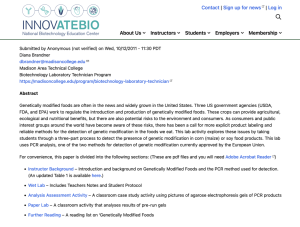Detect Genetically Modified Food

Genetically modified foods are often in the news and widely grown in the United States. Three US government agencies (USDA, FDA, and EPA) work to regulate the introduction and production of genetically modified foods. These crops can provide agricultural, ecological and nutritional benefits, but there are also potential risks to the environment and consumers. As consumers and public interest groups around the world have become aware of these risks, there has been a call for more explicit product labeling and reliable methods for the detection of genetic modification in the foods we eat. This lab activity explores these issues by taking students through a three-part process to detect the presence of genetic modification in corn (maize) or soy food products. This lab uses PCR analysis, one of the two methods for detection of genetic modification currently approved by the European Union. For convenience, the resource is divided into five sections, all PDF files, including background, wet lab, paper lab, assessment and further reading.

Comments